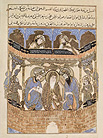The Age of the Book (750–1100 CE)
From the second through the fourth century of Islam, the literary arts blossomed. Scholars perfected the Arabic script and developed rules of grammar for explaining and teaching classical Arabic. They collected hadith reports, wrote them down, and developed a method to distinguish grades of reliability. They collected the vast storehouse of Bedouin Arabic poetry from rawis, wrote down the poems, edited them into anthologies and into diwans (life works of major poets), composed biographies of the great poets of earlier times, and created the science of metrics, even as styles and taste continued to evolve among new generations of poets. They wrote down the Nahj al-Balagha, a collection of khutbas or speeches attributed to Muhammad’s cousin and son-in-law `Ali (d. 661 CE) that became a standard for both its teachings on morality and religion and for the elegance of its style.
Middle Eastern scholars benefitted by the information revolution created in the Middle East when an originally Chinese invention, paper, was wedded to a new culture of the book. Paper was less expensive and more malleable than previous writing surfaces, papyrus and animal skin parchment. The enhanced literary productivity and new technologies of paper and book production resulted in the great libraries of Baghdad, Cairo, and Cordoba and in the burgeoning collections in homes, schools, and shrines across the Islamic world.
Christian, Jewish, and Muslim scholars debated one another in Arabic, worked together to translate large parts of the heritage of Greek, Persian, and Indian civilization into Arabic, and created robust literatures in the areas of philosophy, theology, qur’anic and biblical commentary, and adab—a term that refers to diverse array of literary genres from travelogues to advice for princes, to essays on personal morality, theology, poetic style, wine-drinking, and grammar. Popular oral tradition such as The Romance of `Antar (a pre-Islamic hero, poet, and lover) and The Arabian Nights expanded rapidly even as scholars composed treatises on law, ethics, mystical theology, and the lives and sayings of early mystics. Ferdowsi (d. 1020 CE) composed the first major work in Farsi (the new version of Persian that re-emerged after the Arab conquest with a new Arabic script), a poetic epic known as the Shahnameh (Book of Kings). This was followed by developments such as the rubaiyat (lyric quatrains) attributed to Omar Khayyam (d. 1190 CE) and the epic romances of Nezami (d. 1209 CE).

 Michael Sells
Michael Sells
John Henry Barrows Professor of Islamic History and Literature, Divinity School, The University of Chicago
Guiding Questions
1. When was the Age of Voice, and what two major areas of concern dominated the Age of Voice?
2. How did literary traditions reflect tension between different empires in the Middle East from the sixteenth to nineteenth centuries CE?
3. What kind of impact has conflict between Middle Eastern and other cultures had Middle Eastern literary movements, both in the early part and final centuries of the second millennium CE?


 Print Page
Print Page

